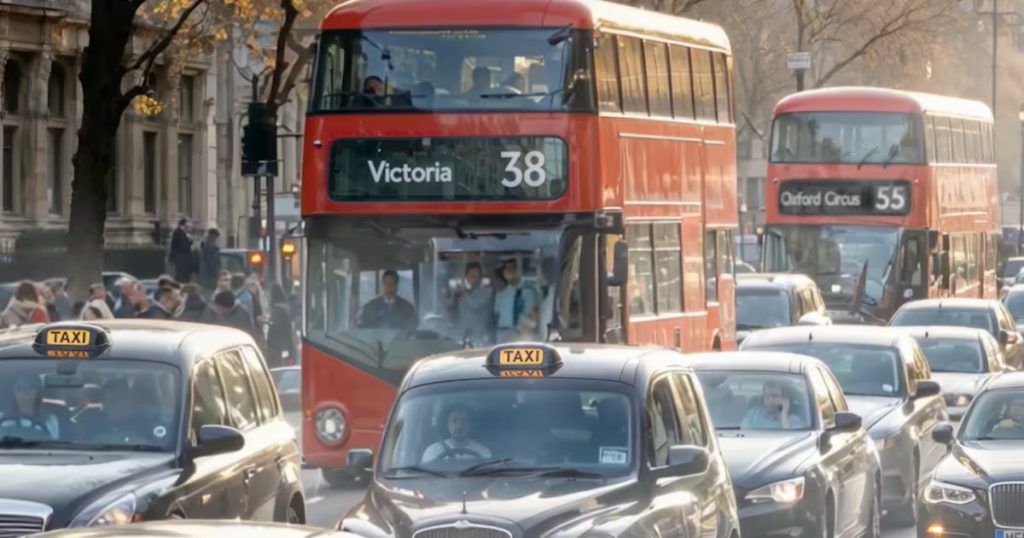London remains the UK’s most congested city and ranks as the fifth worst globally, according to our latest Traffic Index. The average driver in London, on an average day, spent just over 33 minutes to travel 10km in 2024. That number puts the city ahead of Dublin and Paris for the dubious title of most congested in Europe.
With congestion increasing in 34 out of 35 UK cities in 2024, the capital’s mounting traffic crisis shows no sign of slowing down. But just how bad is the situation, and what can be done to mitigate it?
The growing congestion challenge
Our Traffic Index analysis paints a stark picture: last year, Londoners lost an average of 113 hours to traffic delays during peak times, with congestion levels hitting 32%, which is a 3% rise compared to 2023.
The average speed was a sluggish 18 km/h (11.2 mph), which translates to an extra eight minutes per trip compared to free-flowing traffic. This delay takes a toll not only on commuters but also on businesses, straining productivity and efficiency. The impact on quality of life for Londoners is also significant.
Adding to the problem, London’s historic road network – originally designed for a much smaller population – struggles to accommodate the high volumes of vehicles driving through the city centre today. As Mayor Sadiq Khan has described it, the city is like “400 Roman villages” pieced together. Narrow streets and ongoing construction projects only exacerbate the gridlock.
Economic impact on tourism and businesses
The effects of these delays extend beyond daily frustration. The UK’s travel and tourism industry faces potential losses of up to £60 billion in economic output over the next decade due to high taxes and other factors deterring visitors.
In London, heavy traffic may discourage tourists from fully experiencing the city’s attractions, dining spots, and shops. For local businesses, congestion means delivery delays, higher fuel costs, and longer working hours – each of which erodes profitability and affects employment.
Interestingly, while central London struggles with severe gridlock, suburban areas fare somewhat better, averaging a 10km journey in around 20 minutes with approximately 68 hours lost annually. However, even these “better” figures reflect the broader issue: demand exceeds road capacity across the metropolitan areas of the capital.
The rush hour effect
No aspect of London’s traffic woes illustrates the problem more vividly than rush hour. In the morning, a 10 km journey takes approximately 39 minutes and 23 seconds (with speeds around 15.2 km/h), while in the evening, it stretches to about 40 minutes and 14 seconds (at roughly 14.9 km/h). Londoners typically lose about 46 minutes every day just to commute during peak times—a daily drag on productivity and quality of life.
Policy measures and data-driven solutions
Over the past two decades, initiatives such as the Congestion Charge and the introduction of Ultra Low Emission Zones (ULEZ) have aimed to reduce vehicle numbers in the city centre and improve air quality. More recently, plans to pedestrianise areas like Oxford Street, which is modelled after successes such as New York’s Times Square, offer hope for creating safer, more attractive urban spaces.
However, while these measures have yielded some benefits, the sheer volume of almost ten million car journeys in London each day (according to the TfL’s Mayor’s Transport Strategy) means that innovative, data-driven solutions remain essential for efficient traffic management. Interestingly, approximately 30% of these journeys could be completed on foot in under 25 minutes, and around 1.7 million of these could easily be made by bus. These insights underscore the potential for reducing congestion through smarter travel choices and enhanced public transport options.
Real-time data plays a key role here, by identifying congestion hotspots and suggesting alternative routes. This technology can help reduce delays and optimise road use. For local authorities, access to detailed mapping data enables more proactive traffic management, helping to adjust timings, implement dynamic road pricing, and design smarter urban planning initiatives. With predictive analytics, authorities can anticipate traffic surges before they happen, limiting bottlenecks in real time and improving overall mobility.
Such insights also inform long-term infrastructure investments – whether it’s expanding public transportation networks, improving cycling infrastructure, or implementing smarter traffic management systems.
Building smarter cities
As we look to the future, London’s transport system is shifting towards a more integrated, multi-modal approach. Cities like Amsterdam and Copenhagen have successfully blended buses, trams, bikes, and pedestrian pathways, fostering environments where reliance on cars is significantly reduced. These cities have shown that when public transport and alternative mobility options are made efficient, safe, and convenient, they can transform urban life.
In London, Transport for London (TfL) is already working towards a target of cutting three million car trips per day by 2041 through improved public transit and incentivising alternative modes of transport. But achieving this vision requires a fundamental shift in how the city’s streets are used and perceived. Making urban areas safer and more attractive for walking, cycling, and public transit is key.
Technology will be a pivotal force in this transition, with smart systems guiding everything from traffic flow to personal transport choices. London’s ongoing expansion of bike-sharing schemes, the development of on-demand ride services, and the growth of electric vehicle charging infrastructure all point toward a future where the need for personal car ownership diminishes.
Paving the way for a congestion-free future
London’s increasing congestion levels is a complex challenge that impacts residents, tourists, and businesses alike. By harnessing real-time data, investing in smart infrastructure, and embracing sustainable transport initiatives, there is a clear pathway to a more efficient and liveable city. Collaboration between city planners, businesses, and the public is key to transforming London’s transport system. This will ensure that the capital supports its economic ambitions and improves the quality of life for its inhabitants.
- Andy Marchant, Traffic Expert at TomTom


